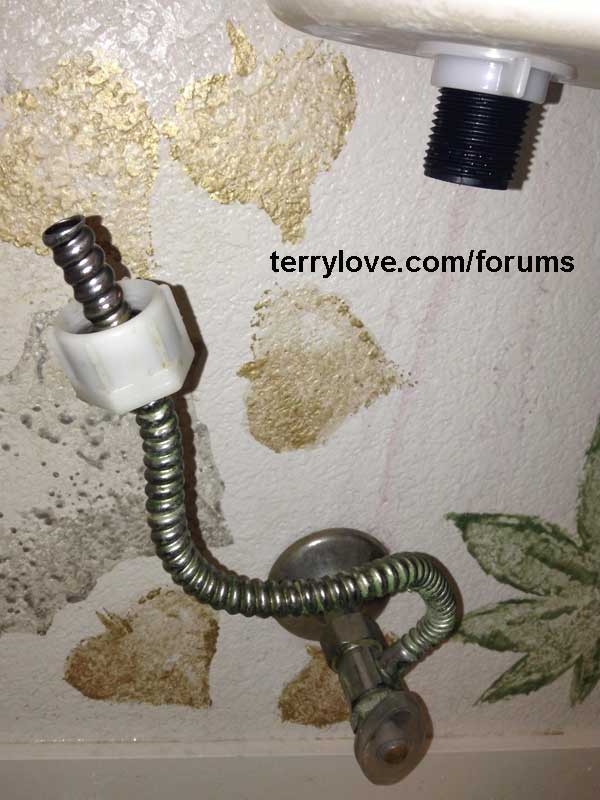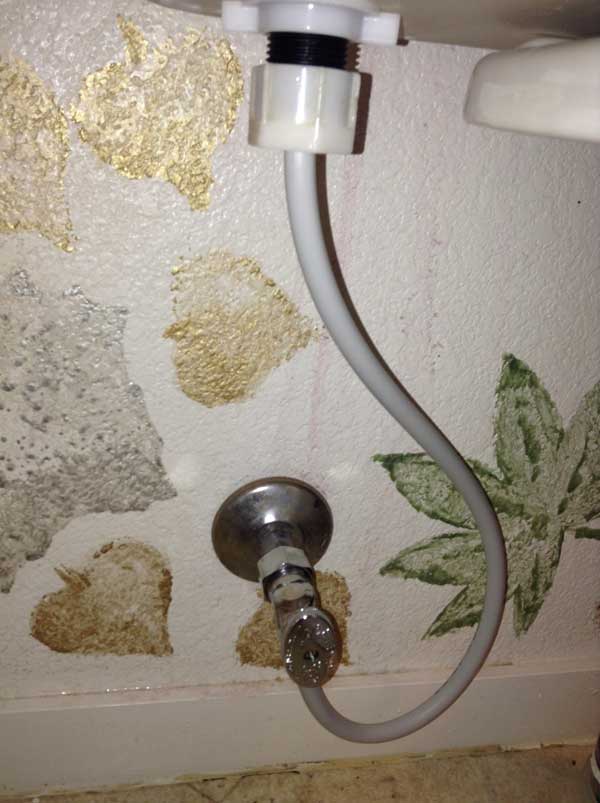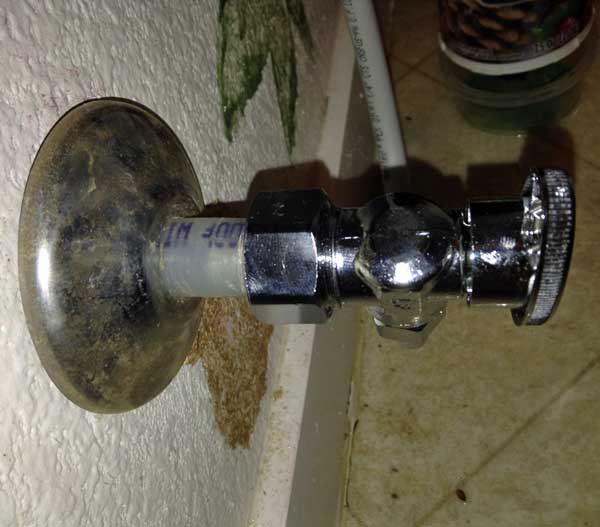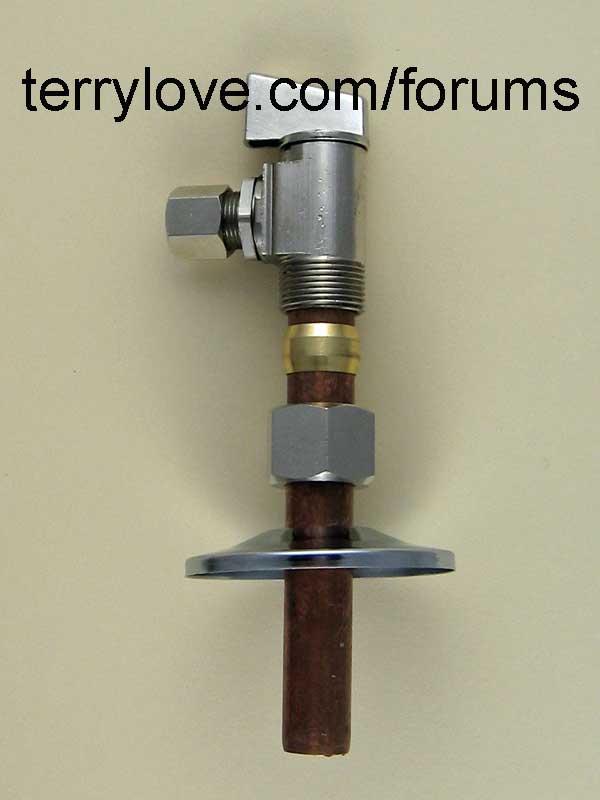Flapper
Member
After seeing Terry's advice to always replace corrugated supply lines, and the info about sleeve pullers, I thought I'd replace the one on the downstairs toilet where I replaced the fill valve but not the supply line. It wasn't leaking and it worked fine so I took a good look at it. I discovered that if I push against the tube next to the nut & seal, water sprays out, so I thought, "Hell yeah I'm replacing this!"
Here's the old supply & valve:

At the store I did a quick look on how to replace a stop valve but I didn't really find what I was looking for, but I did find that the sleeve can be removed without a sleeve puller. I got a sleeve puller anyway just in case.
After removing the valve, first I tried just pulling at it but it wouldn't budge, so second I tried using the sleeve puller but there was a problem. The insert thing that goes into the pipe, didn't fit into the pex pipe with the ferrule. So lastly I removed it by cutting it with a hacksaw until it broke.
I put the new one on and after tightening it, it still was able to rotate.
There were no leaks when I turned the water back on! Even with the water on, I was still able to rotate the valve. Are compression-fitting valves supposed to be able to rotate when attached? The old one didn't.
I used a PEX supply line to connect to the toilet because they were on sale for 27¢.
To connect the line to the toilet valve, I used the old nut from the corrugated line, just removed the seal and washer.
After trying to figure out where to cut it and how to orientate it, I decided instead to loop around and connect to the valve from below (no cutting needed). I rotated the valve 180˚ with the water pressure on
After turning it on, there was a little tiny bit of leaking at the connection to the valve but after a few tightenings it was stopped.
Everything's hunky-dory now!
Pics:
The finished product :
:


How is the job? Is the installation good?
For the PEX to valve connection, I used the plastic sleeve supplied with the tube, and the valve's nut. The valve came with a brass sleeve which I think is for copper lines, but it can be used for PEX lines too, but the PEX needs an insert, right? What happens if I connect the PEX using the brass sleeve without an insert? The plastic sleeve seems to work the same as a brass sleeve but it doesn't use an insert.
Are compression fittings supposed to be able to rotate even with the water pressure on?
What do you do if you cut your stub-out too short?
(may have more questions that I can't think of right now)
Thanks to Terry for suggesting to replace corrugated lines and for telling that crimp sleeves can be removed. This is my second stop valve replacement and this time it came out well. The first time I replaced a stop valve (for the upstairs toilet) it didn't come out well. First I tried using a new compression valve with the old nut and sleeve (I think we did that with the backyard spigot and it worked fine) but it leaked so I had to use my first plan (the push-fit valve).
I did not know that the sleeve could be removed, I thought it was permanently attached, so I cut it off, and ended up with a shorter stub-out. I used a push-fit valve. The pipe was not cut very squarely and it was kinda rough from the old nut and flange thing and stuff, so I was worried it would leak. Luckily it didn't leak, but unfortunately the flange thing didn't fit.
Here's the old supply & valve:

At the store I did a quick look on how to replace a stop valve but I didn't really find what I was looking for, but I did find that the sleeve can be removed without a sleeve puller. I got a sleeve puller anyway just in case.
After removing the valve, first I tried just pulling at it but it wouldn't budge, so second I tried using the sleeve puller but there was a problem. The insert thing that goes into the pipe, didn't fit into the pex pipe with the ferrule. So lastly I removed it by cutting it with a hacksaw until it broke.
I put the new one on and after tightening it, it still was able to rotate.
There were no leaks when I turned the water back on! Even with the water on, I was still able to rotate the valve. Are compression-fitting valves supposed to be able to rotate when attached? The old one didn't.
I used a PEX supply line to connect to the toilet because they were on sale for 27¢.
To connect the line to the toilet valve, I used the old nut from the corrugated line, just removed the seal and washer.
After trying to figure out where to cut it and how to orientate it, I decided instead to loop around and connect to the valve from below (no cutting needed). I rotated the valve 180˚ with the water pressure on
After turning it on, there was a little tiny bit of leaking at the connection to the valve but after a few tightenings it was stopped.
Everything's hunky-dory now!
Pics:
The finished product


How is the job? Is the installation good?
For the PEX to valve connection, I used the plastic sleeve supplied with the tube, and the valve's nut. The valve came with a brass sleeve which I think is for copper lines, but it can be used for PEX lines too, but the PEX needs an insert, right? What happens if I connect the PEX using the brass sleeve without an insert? The plastic sleeve seems to work the same as a brass sleeve but it doesn't use an insert.
Are compression fittings supposed to be able to rotate even with the water pressure on?
What do you do if you cut your stub-out too short?
(may have more questions that I can't think of right now)
Thanks to Terry for suggesting to replace corrugated lines and for telling that crimp sleeves can be removed. This is my second stop valve replacement and this time it came out well. The first time I replaced a stop valve (for the upstairs toilet) it didn't come out well. First I tried using a new compression valve with the old nut and sleeve (I think we did that with the backyard spigot and it worked fine) but it leaked so I had to use my first plan (the push-fit valve).
I did not know that the sleeve could be removed, I thought it was permanently attached, so I cut it off, and ended up with a shorter stub-out. I used a push-fit valve. The pipe was not cut very squarely and it was kinda rough from the old nut and flange thing and stuff, so I was worried it would leak. Luckily it didn't leak, but unfortunately the flange thing didn't fit.
Last edited by a moderator:

